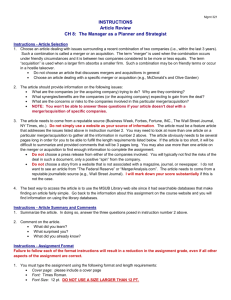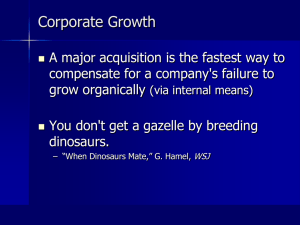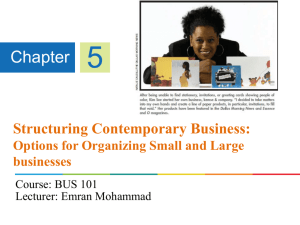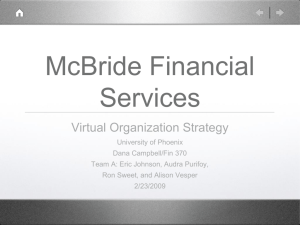Brief description of Merger, Acquisition, Joint venture Strategy
advertisement
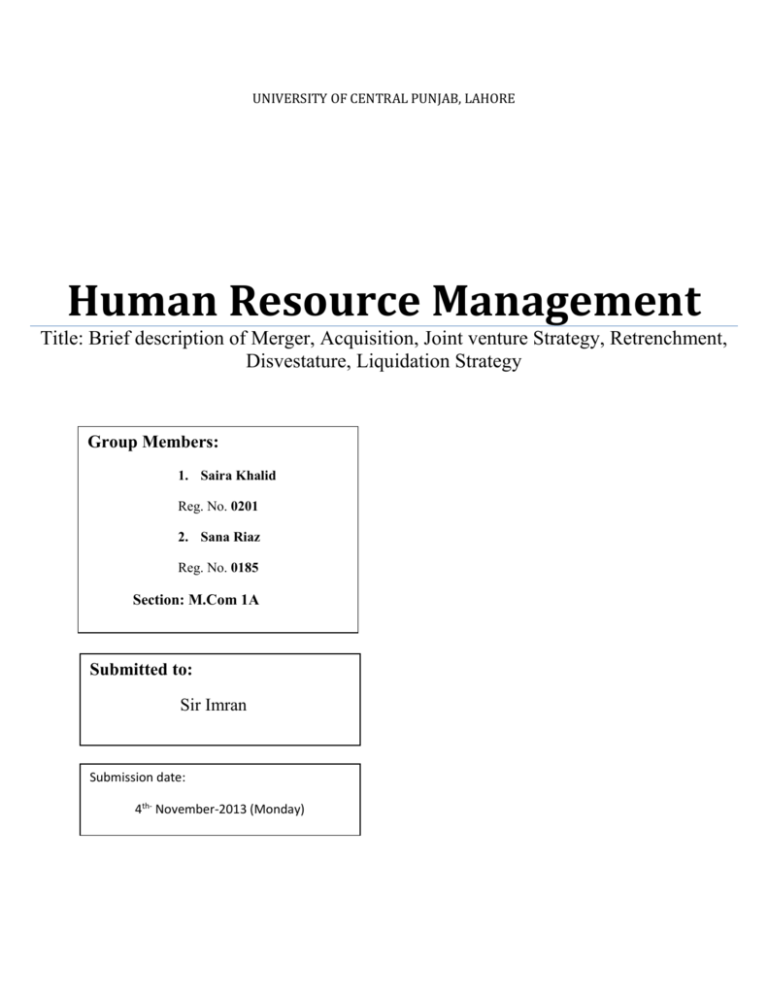
UNIVERSITY OF CENTRAL PUNJAB, LAHORE Human Resource Management Title: Brief description of Merger, Acquisition, Joint venture Strategy, Retrenchment, Disvestature, Liquidation Strategy Group Members: 1. Saira Khalid Reg. No. 0201 2. Sana Riaz Reg. No. 0185 Section: M.Com 1A Submitted to: Sir Imran Submission date: 4th- November-2013 (Monday) Term to be defined: Joint Venture Strategy Merger Acquisition Liquidation Strategy Disvestature Retrenchment Joint Venture Strategy: Definition: A business agreement between two different companies to work together to achieve specific goals. A strategic joint venture does not have to be permanent. Companies maintain their independence and identities as individual companies. Offset one or more weaknesses with another company's strengths. OR A joint venture (JV) is a business agreement in which the parties agree to develop, for a finite time, a new entity and new assets by contributing equity. Characteristics of Joint Venture Strategy: Shared contribution of equity Shared authority Shared control Shared responsibility Shared profits and losses Shared assets Reasons of forming a Joint Venture: Pursue larger opportunities than they could alone Establish a presence in a foreign country Gain a competitive advantage in a particular market. Help companies to lower costs Gain access to another company's technology Increase revenues, Increase their customer base Expand product distribution Steps of formation of Joint Venture: Following are the steps for the formation of a joint venture: planning partner search checking feasibility incorporation 1. Planning: First of all the planning is made that either they should form this strategy or it will disturb the workings of business. After making full research on every aspect, we will move further to next steps. 2. Partner Search: After planning, we will make search of a partner through which we form our joint venture. That partner will be chosen who is willing and be helpful for our company or corporation. 3. Check feasibility: After that the partner who has been chosen must be given interpretation about his financial position, policies and our company’s circumstances. 4. Incorporation: If we are satisfied with company’s position and everything, then, incorporation with that company will be formed. Examples: Sony Ericsson Hero Honda Sony Ericsson: Ericsson first formed the joint venture with General Electric and became a recognized brand for cellular phones in early ninety’s. After that General Electric left and Ericsson began to obtain mobile chips from Philips. But Philips caught fire in factory in New Mexico and Ericsson’s production was disturbed. A mistake by Ericsson was that he waited for Philips for a year and suffered losses. Then Ericsson’s position was disturbed. To curtail the losses, it considered outsourcing production to Asian companies that could produce the handsets for lower costs. After that he formed a joint venture contract with Sony which was a popular brand that times and was a marginal player in the worldwide mobile phone market with a share of less than 1 percent in 2000. By August 2001, the two companies had finalized the terms of the merger announced in April. . The stated reason for this venture is to combine Sony's consumer electronics expertise with Ericsson's technological leadership in the communications sector Hero Honda: Hero motors was manufacturing more than 16000 bikes per day. They sold 86 million bikes (approx.) in 2002. They served all the expansive markets in India. Hero wanted to serve mediocer’s market too. Honda was working in the field of scooters and wanted to manufacture bikes to serve another market. So, the reasons were: “To make bikes with low cost using kinetic energy”. In April, 1984 Hero Cycles, India and Honda Motor Company, Japan inked a joint venture and the world's single largest motorcycle company was born. Hero Honda Motors Limited (HHML) is the World No. 1 two wheeler company and one of Honda Motor Company's most successful joint ventures, globallyHero Honda has sold over 15 million motorcycles and has consistently shown a double digit growth since its inception. Today, every second, a motorcycle sold in the country is a Hero Honda. Both the companies, through this collaboration became India’s largest two-wheelers seller but by the end of 2010, this joint venture agreement ended due to certain reasons. Merger Definition: The combining of two or more companies, generally by offering the stockholders of one company securities in the acquiring company in exchange for the surrender of their stock. Types of merger: Agreed Merger Hostile Merger Agreed merger: When the merger occurs, by the formation of contract, between two companies. Or when the companies themselves, with their own will form a contract that they will become one company or work together as one company. Hostile Merger: When, one company seeks to control another without its agreement. This is called a hostile takeover. To avoid a hostile takeover the target company may seek a 'white knight', another company with which it would prefer to merge. Reasons for merger: There are many motivations for mergers. 1. Expansion: A larger, growing company may try to take over its smaller rivals in order to grow bigger. 2. Lack of capital: In some cases it is the smaller company that wants to expand, but is hampered by lack of capital. It seeks a larger partner who will put in the necessary investment. 3. Cost saving: Other mergers seek to make cost-savings by integrating operations, sometimes on a world scale. 4. Defensive: Some mergers are defensive, responding to other mergers which threaten the competitive position of a company. Types of merger: Horizontal merger Vertical merger Co-generic merger Conglomerate merger 1. Horizontal Merger: This kind of merger exists between two companies who compete in the same industry segment. The two companies combine their operations and gains strength in terms of improved performance, increased capital, and enhanced profits. This kind substantially reduces the number of competitors in the segment and gives a higher edge over competition. 2. Vertical Merger: Vertical merger is a kind in which two or more companies in the same industry but in different fields combine together in business. In this form, the companies in merger decide to combine all the operations and productions under one shelter. It is like encompassing all the requirements and products of a single industry segment. 3. Co-Generic Merger: Co-generic merger is a kind in which two or more companies in association are some way or the other related to the production processes, business markets, or basic required technologies. It includes the extension of the product line or acquiring components that are all the way required in the daily operations. This kind offers great opportunities to businesses as it opens a hue gateway to diversify around a common set of resources and strategic requirements. 4. Conglomerate Merger: Conglomerate merger is a kind of venture in which two or more companies belonging to different industrial sectors combine their operations. All the merged companies are no way related to their kind of business and product line rather their operations overlap that of each other. This is just a unification of businesses from different verticals under one flagship enterprise or firm. Examples: Disney Pixar merger Union bank and Standard Chartered bank Disney Pixar Merger: Pixar Animation Studios is an American computer animation film studio based in Emeryville, California. The studio is best known for its CGI-animated feature films created with Photo Realistic Render Man, its own implementation of the industry-standard Render Man image-rendering application programming interface used to generate high-quality images. Pixar began in 1979 as the Graphics Group, part of the computer division of Lucasfilm before its spin-out as a corporation in 1986 with funding by Apple Inc. co-founder Steve Jobs, who became its majority shareholder. The Walt Disney Company bought Pixar in 2006 at a valuation of $7.4 billion, a transaction which made Jobs Disney's largest shareholder. The Walt Disney Company, commonly known as Disney, is an American diversified multinational mass media corporation headquartered in Walt Disney Studios, Burbank, California. It is the largest media conglomerate in the world in terms of revenue. Disney was founded on October 16, 1923, by Walt and Roy Disney as the Disney Brothers Cartoon Studio, and established itself as a leader in the American animation industry before diversifying into live-action film production, television, and travel. Mickey and Nemo. Pinocchio and “Toy Story.” Cinderella and “Cars.” The merger of legendary Walt Disney and everything-we-create-kids-adore Pixar was a match made in cartoon heaven. Disney had released all of Pixar’s movies before, but with their contract about to run out after the release of “Cars,” the merger made perfect sense. With the merger, the two companies could collaborate freely and easily. Union bank and Standard Chartered bank: Standard chartered bank was a fast growing bank all over the world. It wanted expansion in Pakistan and purchased Union bank of Pakistan considering it more strong organization. Another reason was that union bank was fastly purchasing foreign banks and it had merged with bank of America and bank of Emirates bank international. In 2006, Standard Chartered Bank acquired 81% of Union Bank's shares for US$413 million. Under Pakistani law, it had to delist Union Bank and make an offer for the outstanding shares; the offer raised the total purchase price to about US$511. On 30 December 2006, Standard Chartered merged Union Bank with its own subsidiary in Pakistan, which has 46 branches in 10 cities. The merged bank is named Standard Chartered Bank (Pakistan) and is now Pakistan's sixth largest bank. Acquisition: Definition: A corporate action in which a company buys most, if not all, of the target company's ownership stakes in order to assume control of the target firm. Acquisitions are often made as part of a company's growth strategy. Types of Acquisition: Friendly Acquisition Hostile acquisition Friendly Acquisition: A situation in which a target company's management and board of directors agree to a merger or acquisition by another company. In a friendly takeover, a public offer of stock or cash is made by the acquiring firm, and the board of the target firm will publicly approve the buyout terms, which may yet be subject to shareholder or regulatory approval. Hostile Acquisition: The acquisition of one company (called the target company) by another (called the acquirer) that is accomplished not by coming to an agreement with the target company's management, but by going directly to the company's shareholders or fighting to replace management in order to get the acquisition approved. A hostile takeover can be accomplished through either a tender offer or a proxy fight. Reasons for Acquisition: Economy to scale Cutting costs Replacing leadership Diversifying products or services Gaining a competitive advantage or larger market share Examples: Microsoft and Nokia Microsoft and Skype Google and Motorola Mobile Microsoft and Nokia: Microsoft Corporation and Nokia Corporation announced that the Boards of Directors for both companies have decided to enter into a transaction whereby Microsoft will purchase substantially all of Nokia’s Devices & Services business, license Nokia’s patents, and license and use Nokia’s mapping services. Under the terms of the agreement, Microsoft will pay EUR 3.79 billion to purchase substantially all of Nokia’s Devices & Services business, and EUR 1.65 billion to license Nokia’s patents, for a total transaction price of EUR 5.44 billion in cash. Microsoft will draw upon its overseas cash resources to fund the transaction. The transaction is expected to close in the first quarter of 2014, subject to approval by Nokia’s shareholders, regulatory approvals and other closing conditions. Building on the partnership with Nokia announced in February 2011 and the increasing success of Nokia’s Lumia smartphones, Microsoft aims to accelerate the growth of its share and profit in mobile devices through faster innovation, increased synergies, and unified branding and marketing. For Nokia, this transaction is expected to be significantly accretive to earnings, strengthen its financial position, and provide a solid basis for future investment in its continuing businesses. Microsoft and Skype Acquisition: Microsoft acquired skype in 2011 in the times, when skype itself accepted a bug in the software that sends the instant messages between to persons to third party. Later, skype sent a new update to user which hoped to prevent this problem. Skype was acquired by Microsoft as later was perfect in software building. It helped skype (acquired) to build customer’s confidence again. Google Acquired Motorola: Google Inc. (NASDAQ: GOOG) announced today that the acquisition of Motorola Mobility Holdings, Inc. (NYSE: MMI) has closed, with Google acquiring MMI for $40.00 per share in cash. The acquisition will enable Google to supercharge the Android ecosystem and will enhance competition in mobile computing. Motorola Mobility will remain a licensee of Android and Android will remain open. Google will run Motorola Mobility as a separate business. Acquisition happened on May 22, 2012. Divestatature Strategy: Definition: Divestment strategy involves the sales or liquidation of portion of business, or a major division OR The partial or full disposal of an investment or an asset through sale or exchange, A company will often divest an asset which is not performing well or which is not vital to the co’s core business. Reasons of Divestature: Decisions to divest may be made for a number of reasons: Market share too small. Availability of better alternatives. Need for increased investment. Lack of strategic fit. Legal pressures to divest. Examples of Divestature: 1. Tata Oil Mill (TOMCO) was divested and sold to Hindustan Levers as soaps and a detergent was not considered a core business for the Tata’s. 2. Harcourt General, the large US publisher, is selling its Neiman Marcus division Retrenchment Strategy: Definition: A Retrenchment Strategy is followed when an organization aims at a contraction of its activities through substantial reduction or the elimination of the scope of one or more of its businesses in terms of their respective customer group, customer function or use of an alternative technology. Reasons of Retrenchment : New organization reforms New dominated technologies Adverse government policy Changing customers needs and wants Emergence of substitute products Example of Retrenchment: 1. Nokia changes direction Nokia’s new CEO Stephen Elop issued his famous “burning platform” email in Feb 2010 highlighting the need for significant strategic change at Nokia Since then, there have been over 30,000 job losses at Nokia as the firm has refocused its strategy on partnership with Microsoft. 2. Yell moves to digital Yell, the business directories business, has struggled as demand for paper-based products has declined and it is left with a huge $3bn debt to finance. The new strategy includes a rationalization of the business, further cost-cutting and heftier investment in digital platform. Liquidation Strategy: Definition: The winding-up of a company, a process during which assets are sold, liabilities settled as far as possible, and any remaining cash returned to the members. Liquidation may be voluntary or compulsory. Example of Liquidation: 1. Alpic Finance a non banking finance corporation was ordered to be liquidated by Bombay High Court when it defaulted on its outstanding payments to its investors. 2. El-Ameer Block factory sold all its assets and ceased business ---------------------------------------------------------------------------------------------------------------------
